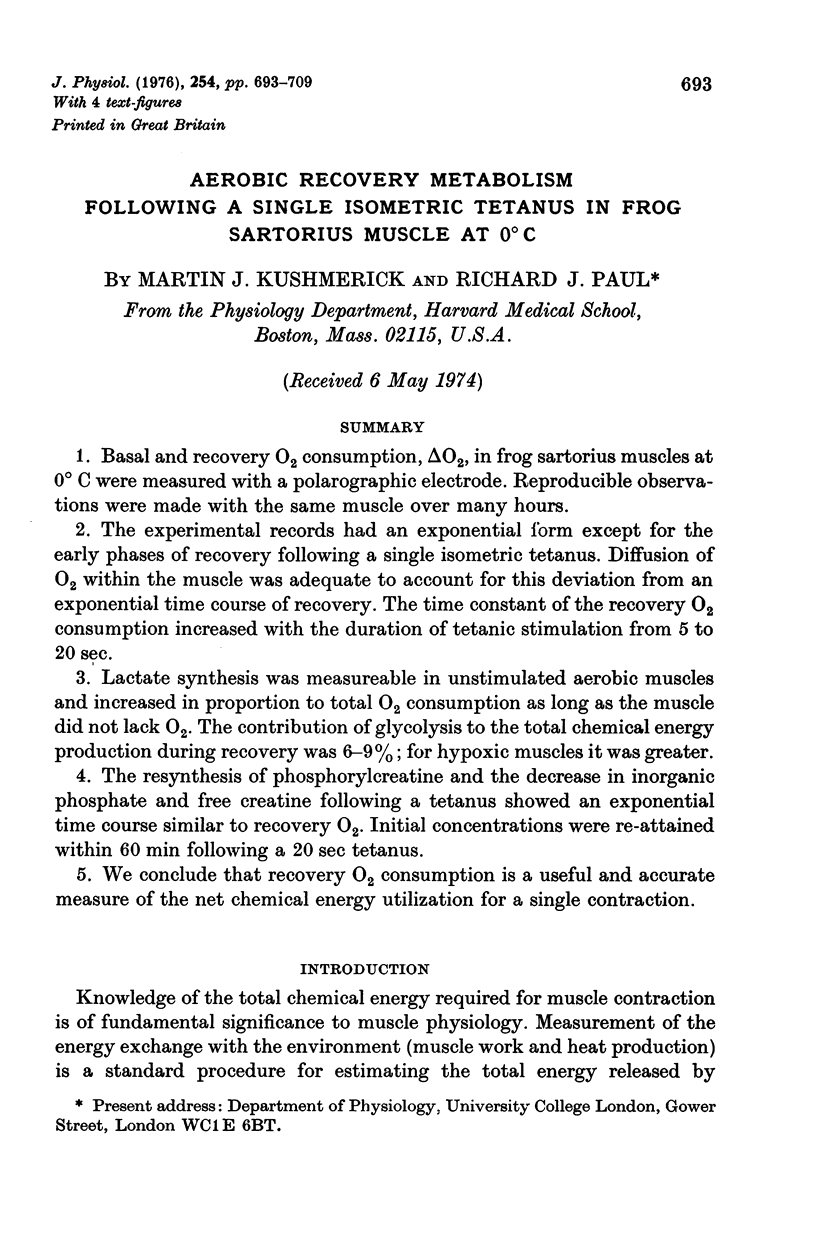Abstract
1. Basal and recovery O2 consumption, delatO2, in frog sartorius muscles at 0 degrees C were measured with a polarographic electrode. Reproducible observations were made with the same muscle over many hours. 2. The experimental records had an exponential form except for the early phases of recovery following a single isometric tetanus. Diffusion of O2 within the muscle was adequate to account for this deviation from an exponential time course of recovery. The time constant of the recovery O2 consumption increased with the duration of tetanic stimulation from 5 to 20 sec. 3. Lactate synthesis was measureable in unstimulated aerobic muscles and increased in proportion to total O2 consumption as long as the muscle did not lack O2. The contribution of glycolysis to the total chemical energy production during recovery was 6-9%; for hypoxic muscles it was greater. 4. The resynthesis of phosphorylcreatine and the decrease in inorganic phosphate and free creatine following a tetanus showed an exponential time course similar to recovery O2. Initial concentrations were re-attained within 60 min following a 20 sec tetanus. 5. We conclude that recovery O2 consumpation is a useful and accurate measure of the net chemical energy utilization for a single contraction.
Full text
PDF
















Selected References
These references are in PubMed. This may not be the complete list of references from this article.
- Baskin R. J. The variation of muscle oxygen consumption with load. J Physiol. 1965 Nov;181(2):270–281. doi: 10.1113/jphysiol.1965.sp007760. [DOI] [PMC free article] [PubMed] [Google Scholar]
- CARLSON F. D., SIGER A. The creatine phosphoryltransfer reaction in iodoacetate-poisoned muscle. J Gen Physiol. 1959 Nov;43:301–313. doi: 10.1085/jgp.43.2.301. [DOI] [PMC free article] [PubMed] [Google Scholar]
- CHANCE B., CONNELLY C. M. A method for the estimation of the increase in concentration of adenosine diphosphate in muscle sarcosomes following a contraction. Nature. 1957 Jun 15;179(4572):1235–1237. doi: 10.1038/1791235a0. [DOI] [PubMed] [Google Scholar]
- CHANCE B., WEBER A. THE STEADY STATE OF CYTOCHROME B DURING REST AND AFTER CONTRACTION IN FROG SARTORIUS. J Physiol. 1963 Nov;169:263–277. doi: 10.1113/jphysiol.1963.sp007255. [DOI] [PMC free article] [PubMed] [Google Scholar]
- Canfield P., Lebacq J., MARECHAL G. Energy balance in frog sartorius muscle during an isometric tetanus at 20 degrees C. J Physiol. 1973 Aug;232(3):467–483. doi: 10.1113/jphysiol.1973.sp010281. [DOI] [PMC free article] [PubMed] [Google Scholar]
- Chaplain R. A., Frommelt B. The energetics of muscular contraction. I. Total energy output and phosphoryl creatine splitting in isovelocity and isotonic tetani of frog sartorius. Pflugers Arch. 1972;334(2):167–180. doi: 10.1007/BF00586789. [DOI] [PubMed] [Google Scholar]
- Curtin N. A., Gilbert C., Kretzschmar K. M., Wilkie D. R. The effect of the performance of work on total energy output and metabolism during muscular contraction. J Physiol. 1974 May;238(3):455–472. doi: 10.1113/jphysiol.1974.sp010537. [DOI] [PMC free article] [PubMed] [Google Scholar]
- Dydyńska M., Wilkie D. R. The chemical and energetic properties of muscles poisoned with fluorodinitrobenzene. J Physiol. 1966 Jun;184(3):751–769. doi: 10.1113/jphysiol.1966.sp007946. [DOI] [PMC free article] [PubMed] [Google Scholar]
- Gilbert C., Kretzschmar K. M., Wilkie D. R., Woledge R. C. Chemical change and energy output during muscular contraction. J Physiol. 1971 Oct;218(1):163–193. doi: 10.1113/jphysiol.1971.sp009609. [DOI] [PMC free article] [PubMed] [Google Scholar]
- Hill D. K. The time course of the oxygen consumption of stimulated frog's muscle. J Physiol. 1940 May 14;98(2):207–227. doi: 10.1113/jphysiol.1940.sp003845. [DOI] [PMC free article] [PubMed] [Google Scholar]
- Homsher E., Rall J. A., Wallner A., Ricchiuti N. V. Energy liberation and chemical change in frog skeletal muscle during single isometric tetanic contractions. J Gen Physiol. 1975 Jan;65(1):1–21. doi: 10.1085/jgp.65.1.1. [DOI] [PMC free article] [PubMed] [Google Scholar]
- JOBSIS F. F. Spectrophotometric studies on intact muscle. II. Recovery from contractile activity. J Gen Physiol. 1963 May;46:929–969. doi: 10.1085/jgp.46.5.929. [DOI] [PMC free article] [PubMed] [Google Scholar]
- Jöbsis F. F., Duffield J. C. Oxidative and glycolytic recovery metabolism in muscle. J Gen Physiol. 1967 Mar;50(4):1009–1047. doi: 10.1085/jgp.50.4.1009. [DOI] [PMC free article] [PubMed] [Google Scholar]
- Kushmerick M. J. Interference with orthophosphate analysis by ATP and phosphorylcreatine. Anal Biochem. 1972 Mar;46(1):129–134. doi: 10.1016/0003-2697(72)90404-6. [DOI] [PubMed] [Google Scholar]
- Kushmerick M. J., Paul R. J. Relationship between initial chemical reactions and oxidative recovery metabolism for single isometric contractions of frog sartorius at 0 degrees C. J Physiol. 1976 Jan;254(3):711–727. doi: 10.1113/jphysiol.1976.sp011254. [DOI] [PMC free article] [PubMed] [Google Scholar]
- LUNDHOLM L., MOHME-LUNDHOLM E., VAMOS N. Lactic acid assay with L(plus)lactic acid dehydrogenase from rabbit muscle. Acta Physiol Scand. 1963 Jun-Jul;58:243–249. doi: 10.1111/j.1748-1716.1963.tb02645.x. [DOI] [PubMed] [Google Scholar]
- Paul R. J., Kushmerick M. J. Apparent P-O ratio and chemical energy balance in frog sartorius muscle in vitro. Biochim Biophys Acta. 1974 Jun 28;347(3):483–490. doi: 10.1016/0005-2728(74)90085-1. [DOI] [PubMed] [Google Scholar]
- STREHLER B. L., TOTTER J. R. Firefly luminescence in the study of energy transfer mechanisms. I. Substrate and enzyme determination. Arch Biochem Biophys. 1952 Sep;40(1):28–41. doi: 10.1016/0003-9861(52)90070-2. [DOI] [PubMed] [Google Scholar]
- Wilkie D. R. Heat work and phosphorylcreatine break-down in muscle. J Physiol. 1968 Mar;195(1):157–183. doi: 10.1113/jphysiol.1968.sp008453. [DOI] [PMC free article] [PubMed] [Google Scholar]


